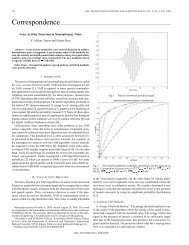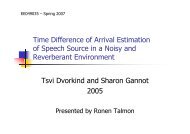Thesis (PDF) - Signal & Image Processing Lab
Thesis (PDF) - Signal & Image Processing Lab
Thesis (PDF) - Signal & Image Processing Lab
Create successful ePaper yourself
Turn your PDF publications into a flip-book with our unique Google optimized e-Paper software.
10 CHAPTER 1. INTRODUCTION<br />
3. A general framework for producing morphological connected and non-connected<br />
operators associated to a given tree representations is developed.<br />
4. A new particular case of tree representation, named Extrema-Watershed Tree, is<br />
proposed. A novel set of morphological operators was defined on the Extrema-<br />
Watershed Tree, based on this general framework.<br />
5. Some applications using morphological filtering, based on the Extrema-Watershed<br />
Tree, are proposed. Those applications include pre-processing for OCR (Optical<br />
Character Recognition) algorithms, intermediate step for image segmentation<br />
and initial step for dust and scratch removal from images.<br />
The thesis is organized as follows:<br />
Chapter 2 provides a theoretical background on semilattices and graph theory,<br />
and summarizes the work presented in [17, 16] . In Chapter 3, we propose an efficient<br />
implementation of the methods defined in [16]. Chapter 4 proposes possible solutions<br />
for the “trench” problem that arises when applying erosion and opening in the semi-<br />
lattice defined in [16]. In Chapter 5 we develop a general framework for tree-based<br />
morphological image processing, which unifies the schemes presented in [17, 16], and<br />
enables the definition of new morphological operators that are based on tree represen-<br />
tations. The heart of the proposed approach is a novel complete inf-semilattice of tree<br />
representations of images. For every tree representation, a complete inf-semilattice<br />
on the tree-representation domain is derived, and a set of morphological operators on<br />
that inf-semilattice is obtained.<br />
Based on the general framework of Chapter 5, all that is needed in order to obtain<br />
a new set of morphological operators is a given tree representation. The more this tree<br />
representation is useful, the more useful these morphological operators will likely be,<br />
since many of the properties of the tree are inherited by the morphological operators<br />
(like self-duality).<br />
Chapter 6 is devoted to the Extrema-Watershed Tree semilattice; a particular<br />
case, obtained from the general framework, and to the investigation of its usefulness.<br />
The Extrema-Watershed Tree is a kind of “Binary Partitioning Tree”, which is<br />
a state-of-the-art general framework for tree generation, developed by Salembier in<br />
[10]. It was designed in order to be used for tasks such as self-dual filtering. The
















